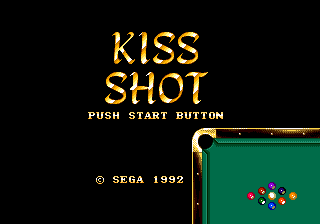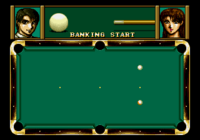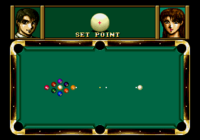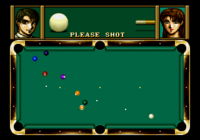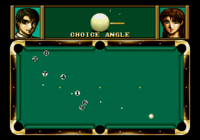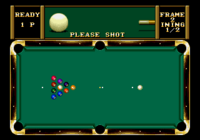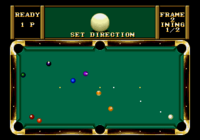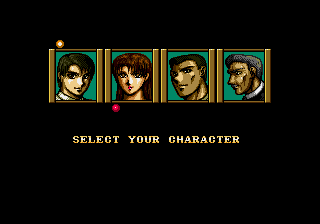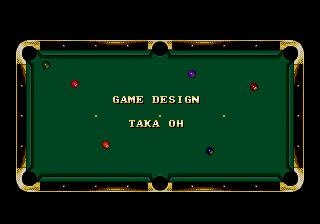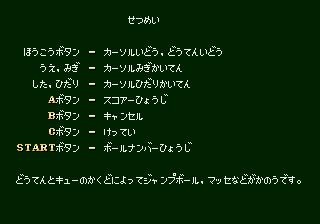Kiss Shot
From Sega Retro
| Kiss Shot | ||||||||||
|---|---|---|---|---|---|---|---|---|---|---|
| System(s): Sega Mega Drive | ||||||||||
| Publisher: Sega Enterprises, Ltd. | ||||||||||
| Developer: Sega CS1 | ||||||||||
| Genre: Table, Sports (billiards) | ||||||||||
| Number of players: 1-4 | ||||||||||
|
Kiss Shot (キスショット) is an billiards game for the Sega Mega Drive, released exclusively in Japan via the Sega Game Toshokan service.
A "kiss shot" is a pool shot where the cue ball is deliberately bounced off one ball in order to hit another.
Contents
Gameplay
Kiss Shot is a pool game. There are two modes, "Nineball" and "Boulards," representing different games with differing rules. In either mode, players must use a cue stick to hit the white cue ball, using it to sink the colored balls into one of the six pockets on the table. The game can be played alone or with other players. Computer-controlled players have a delay where they "think" about their next shot.
On each shot, the player can rotate the direction with ![]() (counterclockwise) or
(counterclockwise) or ![]() (clockwise) to aim the cue stick at the object ball (the ball struck by the cue ball). The aim is shown as a dotted line, which also shows the trajectory if the cue ball bounces off one of the rails (but not necessarily the trajectory taken by the object ball). The player can confirm a selection with
(clockwise) to aim the cue stick at the object ball (the ball struck by the cue ball). The aim is shown as a dotted line, which also shows the trajectory if the cue ball bounces off one of the rails (but not necessarily the trajectory taken by the object ball). The player can confirm a selection with ![]() or go back with
or go back with ![]() .
.
The player then sets the contact point where the cue stick strikes the cue ball, from nine different positions, using the D-Pad. The horizontal position affects the spin put on the cue ball, which helps knock the object ball in the opposite direction. Hitting the ball low causes the cue ball to draw (bounce back toward its origin) after hitting the object ball, while hitting it high causes it to follow (continue its trajectory).
Then the player determines the offset of the cue stick, using ![]() and
and ![]() (with the higher contact points limited to higher angles). Higher angles can be used for massé shots where the cue ball curves back, and lower angles can cause the ball to jump. Finally, the player decides how much power to use to hit the ball, by pressing
(with the higher contact points limited to higher angles). Higher angles can be used for massé shots where the cue ball curves back, and lower angles can cause the ball to jump. Finally, the player decides how much power to use to hit the ball, by pressing ![]() to stop the cue stick as it moves back and forth in front of the ball (with the longer stroke having more power), similar to the swing meter in a golf game.
to stop the cue stick as it moves back and forth in front of the ball (with the longer stroke having more power), similar to the swing meter in a golf game.
Modes
Nineball
This is a version of the game nine-ball. It can be played by one or two players. In the one-player game, the player plays as Ken and faces three computer-controlled opponents (Noriko, Musashi, and Asano). The player must win the best of three racks (games) against each competitor to progress to the next. If the player loses a set, the game ends, but it can be continued with a new set against the last opponent. In two-player games, each player can choose any character (but must choose different characters) and plays a set of 3, 5, or 7 games against each other (using different control pads).
Each set of racks starts by playing a lag. Both competitors strike the cue ball straight ahead from one end of the table to the other. Whichever player shoots the ball such that it ends up closer to the starting rail (on the right side of the table) wins the lag and performs the break shot. The balls are arranged in a diamond shape, and the player who won the lag breaks them by hitting them with the cue ball. After the first rack, the winner of the last rack breaks.
The game is played with nine balls, and the goal is to pocket all of the them in order, starting with 1 and ending with 9. The balls are 1 (solid yellow), 2 (solid blue), 3 (solid red), 4 (solid purple), 5 (solid orange), 6 (solid green), 7 (solid maroon), 8 (solid black), and 9 (striped yellow). The player can press START to show numbers for all of the balls. As long as the cue ball touches the lowest numbered ball first, any balls sunk afterwards are legal (any balls sunk on the break shot are also legal). Otherwise, sinking balls out of order is a foul, which returns the pocketed balls back to the table (on the leftmost marker dot). Pocketing the cue ball is also a foul. If the player pockets a legal ball, the player's inning (turn) continues. If the player fails to pocket any legal balls, the opponent's inning starts, with the opponent having ball in hand if the player fouled but otherwise having to play the balls as they lie.
The player who legally sinks the 9-ball wins the rack. It is possible to sink the 9-ball on the break shot and win the rack immediately. It is also possible to win a rack without the opponent ever being able to take a turn (if the player gets the break shot and successfully sinks every ball in order afterwards).
Boulard
This is an adaptation of bowlliards, a pool game modeled after ten-pin bowling. It can be played by one to four players. The first two players use separate control pads; player 3 shares a control pad with player 1, and player 4 shares a control pad with player 2.
The game is played with ten balls, which can be pocketed in any order. Like bowling, the game is broken into multiple frames; the scorecard can be viewed by pressing ![]() . Every frame starts with a break shot, where the balls are arranged in a triangle and the player breaks them by shooting the cue ball into them. Then the player has two innings (turns) in which to sink as many balls as possible. If the player successfully pockets a ball, the player's inning continues ("Ining Continue"); otherwise, it ends ("Ining Added"). Pocketing the cue ball also ends the inning, with the cue ball returned to the rightmost marker for the next inning.
. Every frame starts with a break shot, where the balls are arranged in a triangle and the player breaks them by shooting the cue ball into them. Then the player has two innings (turns) in which to sink as many balls as possible. If the player successfully pockets a ball, the player's inning continues ("Ining Continue"); otherwise, it ends ("Ining Added"). Pocketing the cue ball also ends the inning, with the cue ball returned to the rightmost marker for the next inning.
The player gains a point for every ball pocketed. A "spare" is given for pocketing every ball in two innings (which is worth 10 points for the frame plus the however many points are earned in the next inning). A "strike" is awarded for pocketing every ball on the first inning (which is worth 10 points for the frame plus however many points are earned in the next two innings). After both innings have been played, the frame ends, and the next frame starts with all of the balls racked again for a break shot.
There are seven frames in a game. Most of the frames have two innings, but the seventh frame has a third inning that is only played if the player achieves a spare or a strike in the first two innings. It is possible to make three strikes in the seventh frame. The last frame is a bonus frame with only nine balls (and again consisting of two innings) where all balls are worth ten points each (for a maximum of 90 possible points, with no additional points awarded for a spare or a strike). Because of the third inning in the seventh frame and the bonus frame, the highest possible score is 300 points, as in bowling, if the player plays a perfect game.
In multiplayer games, players take turns after each frame, and the winner of the game is whoever finishes with the highest score. In a single-player game, there is no computer-controlled adversary; the player simply tries to achieve the best score possible.
Characters
These characters appear in the Nineball mode.
| Ken | |
|---|---|
| This is the player's character in the single-player game. | |
| Noriko | |
| Musashi | |
| Asano | |
Production credits
- Game Design: Taka Oh
- Main Program: Dsk
- Graphic Design: L.C.
- Music Create: Hata, Jimita
- Supervise: Iiyo
- Program Advice: Siro
- Special Thanks: Shinyuu, Otaku
- © Sega 1992
Gallery
Magazine articles
- Main article: Kiss Shot/Magazine articles.
Technical information
- Main article: Kiss Shot/Technical information.
References
| Kiss Shot | |
|---|---|
|
Main page | Technical information | |
